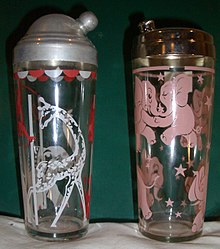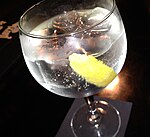Cocktail shaker
This article includes a list of references, related reading, or external links, but its sources remain unclear because it lacks inline citations. (June 2012) |

A cocktail shaker is a device used to mix beverages (usually alcoholic) by shaking. When ice is put in the shaker this allows for a quicker cooling of the drink before serving.
A shaken cocktail is made by putting the desired ingredients (typically fruit juices, syrups, liqueurs and ice cubes) in the cocktail shaker. Then it is shaken vigorously for around 5 to 10 seconds, depending upon the mixability of the ingredients and desired temperature.
There are at least three varieties of cocktail shakers:
- The Boston Shaker: A two-piece shaker consisting of a 28 oz metal bottom and traditionally a 16 oz glass or plastic mixing glass. The mixing container and bottom are inserted into each other for shaking or used separately for stirring or muddling. A separate strainer, such as a Hawthorne or Julep strainer, are required for this type shaker if crushed ice is used. Without such a strainer, some bartenders may instead strain by narrowly separating the two pieces after shaking and pouring the drink through the resulting gap. The market offers now 18 oz or 20 oz container versions too. The unit is the imperial fluid ounce that is about 28,4 ml, so the bottom is about 795 ml and the 16 oz container is about 454 ml.
- The Cobbler Shaker: A three-piece cocktail shaker that has tapers at the top and ends with a built-in strainer and includes a cap. The cap can often be used as a measure for spirits or other liquids.
- The French Shaker: A two-piece shaker consisting of a metal bottom and a metal cap. A strainer is always required for this type of shaker, barring the separation method mentioned above.
History
The cocktail shaker can be traced to 7000 BCE in prehispanic Mexico and South America, where the jar gourd was used as a closed container. In 1520, Cortés wrote to King Charles V of Spain of a drink made from cacao, served to Montezuma with much reverence, frothy and foaming from a golden cylinder. Egyptians as long ago as 3500 BCE added spices to their fermented grain concoctions before serving to make them more palatable.
By the late 19th century, the cocktail shaker as we now know it was in wide use, invented by an innkeeper who, while using two containers to pour drinks back and forth between, noticed that one container's mouth was smaller than the other's and held the two together and shook them "for a bit of a show".

During the 1920s prohibition era in the United States, cocktail shakers were produced in many different shapes and designs, including shakers that looked like penguins, zeppelins, lighthouses and airplanes. Cocktail shaker skills and drink rituals became as important in the Jazz Age lifestyle as knowing the latest dance step. It was after prohibition however, that cocktail shakers really reached their zenith of popularity. They appeared in movies, and were associated with the glamorous lives of movie stars. Cocktail shakers became de rigueur symbols of sophistication and symbols of the good life.
On December 7, 1941, the era of the cocktail shaker faltered seriously, as the United States entered World War II and all non-essential uses of metal were redirected towards the war effort. The same companies and equipment formerly used to manufacture cocktail shakers were used to make artillery shells and other war materials.
In the early 1950s cocktail shakers enjoyed a brief resurgence as soldiers familiar with them returned and became part of the housing boom featuring "rec rooms" with bars. By the later part of the decade though, shakers were quickly giving way to modern electric appliances that either added a mixing unit to the shaker's lid or did away with the shaker entirely, with the introduction of the electric blender.
Patent history
By the mid-1860s, the use of a pair of tumblers to mix drinks was common practice. The patent history involves improvements on this practice:
| Date | Patent No. | Inventor | Invention |
|---|---|---|---|
| December 24, 1872 | #134,274 | William Harnett | Apparatus for mixing 6 drinks at once (six shakers on a turntable) |
| October 30, 1877 | #196,605 | W. H. Trepus | air-vented from the bottom |
| February 1, 1881 | #237,150 | L. H. Williams | mixer with leak-proof edge flaring |
| August 29, 1882 | #263,394 | A. Eggers | combination shaker which allowed the addition of a tumbler if desired |
| January 30, 1883 | #271,350 | W. H. Murphy | mixed beverage shaker which included a spring-loaded strainer |
| June 24, 1884 | #300,867 | E. J. Hauck | the first 3-piece cocktail shaker with a built-in strainer, just as is used today. This design also included an air-vent to allow for faster pouring. |
| September 30, 1924 | #1,509,981 | Louis W. Rice | fluted dome interior feature which could be used as a juicer called a "beverage shaker" instead of "cocktail shaker". |
| April 7, 1925 | #1,532,681 | G. S. Bryce | 3-piece glass shaker with cork, a metal stopper, strainer and metal pouring insert. This was the standard design for the 1920s. |
See also
References
- Bergman, Andrew We're In The Money. Depression America and Its Films. New York University Press, 1971
- Gaylesworth, Thomas & Laylesworth, Virginia New York, The Glamour Years 1919 – 1945 NY Gallery Books, 1987
- Grimes, William Straight Up or On The Rocks, A Cultural History of American Drink NY Simon & Schuster, 1993
- Lifshey, Earl Housewares Story, The, A History of the American Housewares Industry National Manufactures Association, 1973
- Madden, Ethan That Jazz! An Idosyncratic Social History of The American Twenties NY G.P. Putnam's Sons
- Visakay, Stephen Vintage Bar Ware KY Collector Books, 1997
- Wilson, Pilgrim, Tashjian The Machine Age In America 1918 – 1941 Brooklyn Museum, Abrams, NY, 1986
Further reading
- Khachadovrian, Simon (2000). The Cocktail Shaker. London: Philip Wilson Publishers. ISBN 9780856675201


